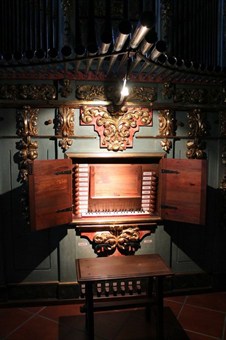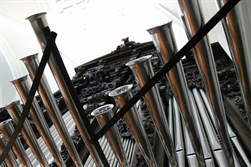Different types of organs in the city and in the court of Madrid
 The organ is a musical instrument that we associate exclusively with a church or a cathedral. Such a use for religious purposes of the organ is attested to from the end of the Middle Ages. Yet the innovations that occurred in the Early Modern period, with the growth of the different courts in Europe and the introduction of a new ceremonial culture which was richer and more luxurious, made of the organ even more of a necessary instrument in celebrations related to religion or royal power. It was certainly from the sixteenth century that the different types of organs clearly emerged in Europe. In the case of the Spanish organ of the Baroque era, among its most outstanding features was the use of the registro partido (divided register), namely, the separation into two distinct sections of registrosA register in the organ is a set of pipes of the same timbre. and tiradoresThe tiradores are knobs that control the different registers, positioned to the side of the keyboard., so sweet sounds or more severe ones can be obtained and modify timbre and intensity. Such a structure had the effect of greatly enriching the musical tones of the organ and to increase the effect on the audience which was listening (photo 1). Another feature of the organ in the Spanish Baroque period was the ability to combine various keyboards in one, so as to give the organist the ability to add different sonorities using a single keyboard. Finally, we must recall the trompetería en batalla, an arrangement of the tubes on the front of the organ as if to form a series of rifles, which is also typical of the Spanish Baroque organ (photo 2).
The organ is a musical instrument that we associate exclusively with a church or a cathedral. Such a use for religious purposes of the organ is attested to from the end of the Middle Ages. Yet the innovations that occurred in the Early Modern period, with the growth of the different courts in Europe and the introduction of a new ceremonial culture which was richer and more luxurious, made of the organ even more of a necessary instrument in celebrations related to religion or royal power. It was certainly from the sixteenth century that the different types of organs clearly emerged in Europe. In the case of the Spanish organ of the Baroque era, among its most outstanding features was the use of the registro partido (divided register), namely, the separation into two distinct sections of registrosA register in the organ is a set of pipes of the same timbre. and tiradoresThe tiradores are knobs that control the different registers, positioned to the side of the keyboard., so sweet sounds or more severe ones can be obtained and modify timbre and intensity. Such a structure had the effect of greatly enriching the musical tones of the organ and to increase the effect on the audience which was listening (photo 1). Another feature of the organ in the Spanish Baroque period was the ability to combine various keyboards in one, so as to give the organist the ability to add different sonorities using a single keyboard. Finally, we must recall the trompetería en batalla, an arrangement of the tubes on the front of the organ as if to form a series of rifles, which is also typical of the Spanish Baroque organ (photo 2).
 It could be thought that in the court of Madrid and the surrounding areas there were no important Baroque organs, since there was a cathedral in the city until the twentieth century. On the contrary, the organs of exquisite workmanship are distributed in different churches in the Comunidad de Madrid, testifying to the importance of the organ in the court and its environs, especially during the Baroque era, a true golden age both for the performers and for composers and builders. Along this itinerary we will illustrate the peculiar characteristics of the Baroque organs of Madrid, their common style but also their Italian and French influences, especially in the field of musical composition as in the construction of the case and the various parts that make up the instrument.
It could be thought that in the court of Madrid and the surrounding areas there were no important Baroque organs, since there was a cathedral in the city until the twentieth century. On the contrary, the organs of exquisite workmanship are distributed in different churches in the Comunidad de Madrid, testifying to the importance of the organ in the court and its environs, especially during the Baroque era, a true golden age both for the performers and for composers and builders. Along this itinerary we will illustrate the peculiar characteristics of the Baroque organs of Madrid, their common style but also their Italian and French influences, especially in the field of musical composition as in the construction of the case and the various parts that make up the instrument.
